
ロースターを載せたコーヒートレーラーを初めて見ました。
At Aoyama UNU farmers market. The coffee tastes good, too.
 旦那の両親が教室を再開しました。手仕事屋久家で、絵画や楽焼や金継ぎを教えます。企画支援もあります。様々な年齢や国籍の人が集まります。私は教室で、最近エアプラントの植木鉢を作りました。杉並区の新高円寺の近くです。お気軽に見学にいらしてください! My in-laws have relaunched their art studio as Kuge Crafts, or Teshigotoya Kuge. They are still teaching pottery and also now kintsugi (a form of decorative repair for ceramics), drawing, and jewelry making. The studio is near Shin Koenji, in Suginami ward. The teachers welcome students from all countries and of all ages. One thing the website doesn’t mention is that delicious cake and coffee are also served at every class! If you’re interested, please call or drop by! Thanks to graphic designer and former student Jessica Mantell and front-end developer Kai Bansner, we made a new website for the studio that is formatted for smart phones, PCs, and tablets.
旦那の両親が教室を再開しました。手仕事屋久家で、絵画や楽焼や金継ぎを教えます。企画支援もあります。様々な年齢や国籍の人が集まります。私は教室で、最近エアプラントの植木鉢を作りました。杉並区の新高円寺の近くです。お気軽に見学にいらしてください! My in-laws have relaunched their art studio as Kuge Crafts, or Teshigotoya Kuge. They are still teaching pottery and also now kintsugi (a form of decorative repair for ceramics), drawing, and jewelry making. The studio is near Shin Koenji, in Suginami ward. The teachers welcome students from all countries and of all ages. One thing the website doesn’t mention is that delicious cake and coffee are also served at every class! If you’re interested, please call or drop by! Thanks to graphic designer and former student Jessica Mantell and front-end developer Kai Bansner, we made a new website for the studio that is formatted for smart phones, PCs, and tablets.

Tanuki offers visitors from the Netherlands warm gingko nuts and hot espresso on a cold night in Yoyogi.
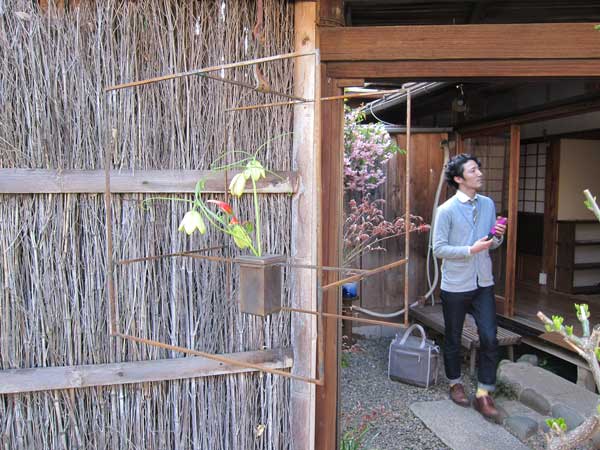
Omotesando Koffee の入口はとても素敵です。美味しいコーヒーが飲めるだけじゃなくて、小さい庭が四季を感じさせてくれます。春に、桜とモクレンが咲いていて、金属製の花瓶には毎週、違う花がいけてあります。おしゃれなお客さんは三年以上の常連で、バリスタオーナが東京に来る前に、大阪のカフェにも行きました。
This is the lovely entrance to Omotesando Koffee. It would be enough just being one of Tokyo’s best espresso coffee bars. O K also sells a single pastry that is eggy and square and incomparable. And O K has a micro-garden that is incredibly charming, with many traditional Japanese plants including maple and a lovely drooping cherry tree with long stemmed flowers.
The fashionable gentleman in the photo explained to me that he used to drink coffee at the Osaka coffee bar run by the same owner, before he moved to Tokyo three years ago. In the foreground is a lovely, metal sculpture and flower vase with understated petals.
Visiting Omotesando Koffee you feel like you’re on a country lane, not in the middle of a mega-city.

この素敵な盆栽はOmotesando Koffeeのオーナが作った作品です。コケが特に元気そうです。表参道に来た時はいつもこの美味しいコーヒーを飲んで、昭和モダンふうのインテリアと庭を楽しみながら、バリスタと話して行きます。
This beautiful bonsai was decorating the very chic Omotesando Koffee shop. The cafe is a modern cube inside a Showa house with a cozy front garden. The very cheerful barista explained that the owner made this bonsai himself. I like how the bonsai looks next to the cappuccino and the aged wood of the house and cupboard. The moss is especially lush and lovely.
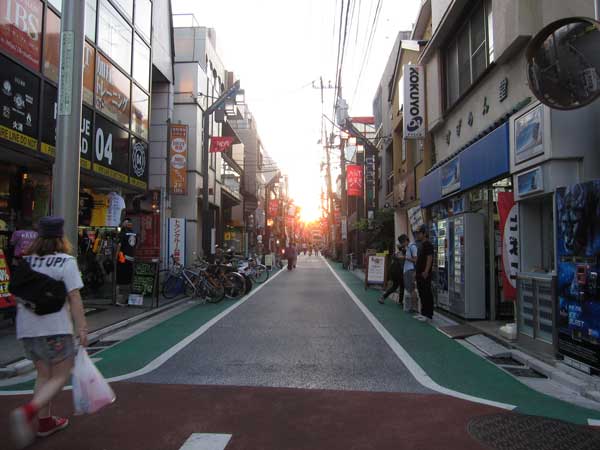
最近、よくこの下北沢の商店街に行きます。日暮れはとてもきれいです。自転車で行けて、おいしいコーヒーのお店があります。東京の商店街には、いろいろ小さな店があります。商店街のデザインは散歩したり、ぶらぶらしたりすることがしやすいようになっています。古いけれど、商店街のストリートデザインはヨーロッパとアメリカで人気が出てきています。どうして都庁は車を支持して、商店街を支持しないのでしょう?
Recently I have been spending more time on this Shimokitazawa shoutengai, or commercial strip full of very small businesses. This one is northwest of the station, and somewhat hard to find. What’s great is its combination of shops run by old timers alongside imported hipster clothes, one of Tokyo’s best coffee shops called Bear Pond that roasts their own beans, a hookah bar, and at least ten hair salons.
There are thousands of these shopping streets in Tokyo, near transit stations and along routes that connect homes, workplaces, schools, and leisure areas. It’s strange that Tokyo Metropolitan Government is still so focused on cars and their movement across the city at the expense of walking and biking and other forms of common space usage. There is little government recognition or support for the idea that these relics of past decades are in fact some of Tokyo’s most forward-looking urban public spaces.
Lively pedestrian zones are common in Europe, and becoming more so in many cities in the United States. By not segregating cars, pedestrians, and bicycles, the street pace slows down to pedestrian speed while still allowing passage for delivery trucks and cars. The way the street is painted makes it appear even more narrow, providing further social cues about speed and usage.
Many of Tokyo’s shoutengai are suffering as consumers shift towards shopping at big box stores and driving as a primary form of transportation. The city government is truly looking backwards when it promotes automobile usage and fails to recognize the value of these vernacular public spaces that support human interaction and the environment.
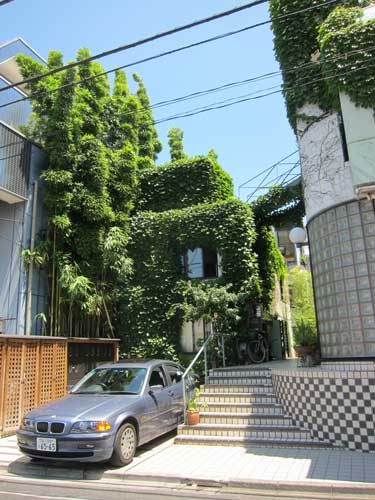
原宿の路地を歩くと、いろいろな庭を見ることができます。おしゃれな建物のグリーンカーテンや戦前からある伝統的な日本庭園もあります。私が好きな庭はシンプルで、たくましくて、さりげないです。大きな青山団地でトマトとゴーヤを見つけました。
With @luismendo visiting from Amsterdam, my Tokyo DIY Gardening pal Chris and I took him on a tour of Harajuku backstreets looking at gardens, eating tonkatsu, and stopping for some excellent cold coffee.
Harajuku is fun because the residential area has houses and gardens from all or almost all the past eight decades. The Harajuku gardens that appeal to me are similar to ones elsewhere in Tokyo for their simplicity and easy adaptation to urban life. Some results are clearly unintentional.
My photos include a three story garden of ivy and bamboo that covers one house and provides a buffer with its neighbor, a sleek concrete building’s balcony green curtains that are just starting to fill out on two floors, a blue flowering vine that somehow became a giant bush, a tiny entrance garden outside a pre-war house that has been converted into the very elegant Omotesando Coffee.
We also explored the enormous Danchi that between 246 road and Harajuku. This sprawling bauhaus-like public housing project has a wonderfully chaotic and varied set of gardens created by generations of residents. In July, we spotted lots of tomatoes, vertical bitter melon, and these purple gloves on top of an ad hoc garden support.

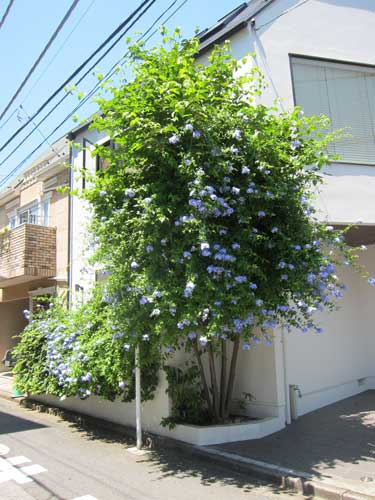

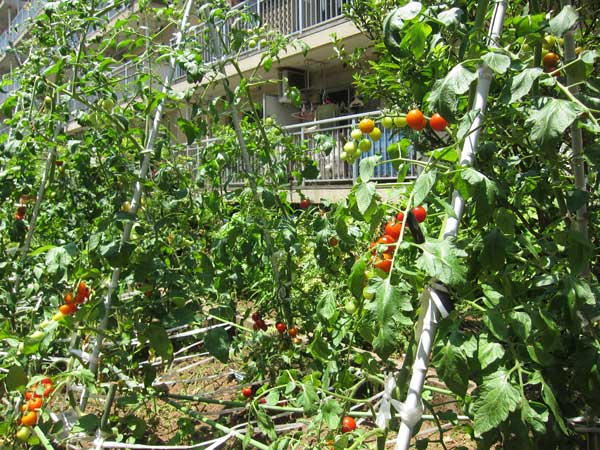



A friend invited me to lunch in Shimbashi, an old business district separated by the Yamanote and several other rail lines from a much newer office area called Shiodome. We ate at a fantastic grilled fish restaurant in the basement of a 1960s “modern” building. On leaving, we passe by this incredible time capsule of a coffee shop, with original light fixtures, furniture, and perhaps the same customers as forty years earlier.
The illuminated Mount Fuji mural is a wonderful example of how Tokyo residents adore this mountain. It reminded me of similar era mosaics found in old sentos. As we passed by, we noticed the medal ceremony for Japanese figure skater Mao Asada broadcast just to the left of Mount Fuji. There was something uncanny about this of-the-moment live broadcast inside an interior that has not changed in decades. This basement level, businessman’s refueling and gathering place is a secular shrine to the beauty of nature.